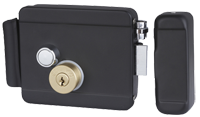| Basic Components of a General Access Control System |
| Credentials |
| Credentials are defined as a physical or tangible object, a piece of knowledge or a facet of a person’s physical being, that enables an individual access into a physical facility or a PC-based information system. |
| Some examples of credentials include card, token, PIN code, fingerprint, face and more. |
| Credentials must be presented by the user before they can be granted access to a secured area. |
| Readers |
| A reader is an electronic component of a physical access control system. |
| The device is used to “read” the access credentials in order to verify a user’s access to a secured area. |
| There are two types of readers for access control systems: |
| Locking Devices |
| There are several types of locking devices used in a card-based access control system: |
 |
| Rim Lock |
| A locking device that attaches to the surface of a door. |
| Easy to install and provides both primary and backup security on any door without much restrictions. |
| Can match any door design as it can be installed in any desired height and location. |
| Controllers/Panels |
| Controllers and panels are used to process access control activities for all doors connected to it. |
| They are normally installed near each door where access control is to be provided. |
| It is there where all connection to the door devices terminates. |
| Some of these panels are integrated with readers. |